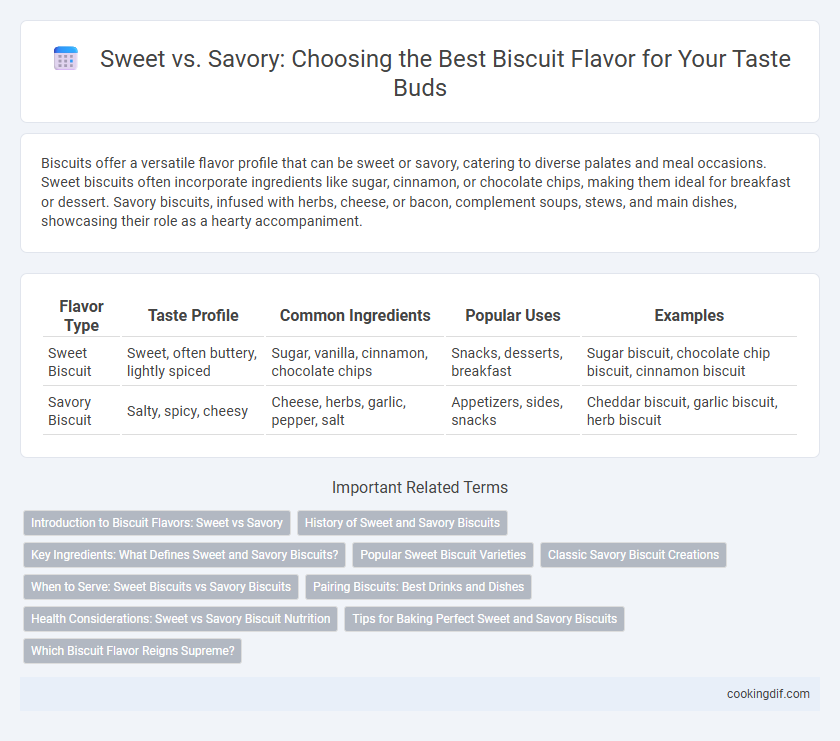Biscuits offer a versatile flavor profile that can be sweet or savory, catering to diverse palates and meal occasions. Sweet biscuits often incorporate ingredients like sugar, cinnamon, or chocolate chips, making them ideal for breakfast or dessert. Savory biscuits, infused with herbs, cheese, or bacon, complement soups, stews, and main dishes, showcasing their role as a hearty accompaniment.
Table of Comparison
| Flavor Type | Taste Profile | Common Ingredients | Popular Uses | Examples |
|---|---|---|---|---|
| Sweet Biscuit | Sweet, often buttery, lightly spiced | Sugar, vanilla, cinnamon, chocolate chips | Snacks, desserts, breakfast | Sugar biscuit, chocolate chip biscuit, cinnamon biscuit |
| Savory Biscuit | Salty, spicy, cheesy | Cheese, herbs, garlic, pepper, salt | Appetizers, sides, snacks | Cheddar biscuit, garlic biscuit, herb biscuit |
Introduction to Biscuit Flavors: Sweet vs Savory
Biscuit flavors vary widely, primarily categorized into sweet and savory profiles that cater to diverse taste preferences. Sweet biscuits often incorporate ingredients like sugar, cinnamon, and chocolate, making them ideal for desserts or snacks. Savory biscuits, on the other hand, feature herbs, cheese, or spices, offering a flavorful option for appetizers or accompaniment to meals.
History of Sweet and Savory Biscuits
Sweet and savory biscuits have distinct historical origins that reflect regional culinary traditions and ingredient availability. Sweet biscuits date back to ancient times when sugar and honey were used as primary sweeteners, evolving significantly in Medieval Europe with the introduction of refined sugar. Savory biscuits emerged from early recipes combining herbs, cheese, and spices to complement meals, especially in British and Middle Eastern cuisines where they served as both snacks and accompaniments.
Key Ingredients: What Defines Sweet and Savory Biscuits?
Sweet biscuits are defined by key ingredients such as sugar, vanilla, and spices like cinnamon, which contribute to their dessert-like flavor profile. Savory biscuits rely on ingredients like cheese, herbs, and salt to create a rich, flavorful taste often paired with meats or soups. The balance between sugar and salt, along with the inclusion of specific flavor enhancers, determines whether a biscuit is categorized as sweet or savory.
Popular Sweet Biscuit Varieties
Popular sweet biscuit varieties include classic chocolate chip, buttery shortbread, and spiced ginger snaps, each offering distinct flavors and textures. These sweet biscuits often feature ingredients like sugar, cinnamon, and vanilla, enhancing their rich taste profiles that contrast with savory options. Their widespread appeal makes them a favorite for tea-time snacks and dessert pairings worldwide.
Classic Savory Biscuit Creations
Classic savory biscuit creations emphasize rich, buttery flavors infused with herbs like rosemary, thyme, or chives, creating a perfect balance of saltiness and depth. Ingredients such as sharp cheddar, garlic, and black pepper enhance the savory profile, making these biscuits ideal accompaniments to soups, stews, and roasted meats. Unlike sweet biscuits that focus on sugar and spices like cinnamon, savory biscuits rely on umami-rich additions to deliver a hearty, satisfying taste experience.
When to Serve: Sweet Biscuits vs Savory Biscuits
Sweet biscuits are ideal for breakfast or dessert, often paired with jams, honey, or fresh fruit to complement their sugary flavors. Savory biscuits serve as excellent accompaniments for soups, stews, and hearty main dishes, enhancing meals with ingredients like cheese, herbs, or bacon. Choosing between sweet and savory biscuits depends on the meal context, highlighting their versatility across different courses and occasions.
Pairing Biscuits: Best Drinks and Dishes
Sweet biscuits pair exceptionally well with hot beverages like coffee, tea, or hot chocolate, enhancing their sugary flavors and providing a comforting balance. Savory biscuits complement hearty dishes such as soups, stews, or fried chicken, alongside rich, creamy gravies or sharp cheddar cheese, creating a satisfying contrast to their buttery, flaky texture. Experimenting with pairing biscuits with fresh fruit preserves or spicy mustard can also elevate the overall tasting experience, highlighting the biscuit's unique flavor profile.
Health Considerations: Sweet vs Savory Biscuit Nutrition
Sweet biscuits typically contain higher sugar content and added fats, contributing to increased calorie intake and potential blood sugar spikes. Savory biscuits often have more sodium due to added salt and flavorings, which can impact blood pressure and heart health when consumed in excess. Choosing biscuits with balanced ingredients and mindful portion sizes supports better nutritional outcomes irrespective of sweet or savory preference.
Tips for Baking Perfect Sweet and Savory Biscuits
Achieving the perfect balance in sweet and savory biscuits requires precise ingredient ratios and baking times, such as using cold butter for flaky texture and adjusting sugar levels for sweetness or herbs for savory depth. Incorporate buttermilk for tender crumb and add flavor enhancers like cinnamon or cheese based on the desired biscuit type. Monitoring oven temperature closely prevents overbaking, ensuring biscuits remain moist and flavorful with a golden-brown crust.
Which Biscuit Flavor Reigns Supreme?
Sweet and savory biscuit flavors each captivate distinct taste preferences, with sweet varieties like cinnamon sugar or chocolate chip appealing to dessert lovers, while savory options such as cheddar or herb-infused biscuits attract those craving a more robust, umami experience. Market trends reveal a growing consumer interest in savory biscuits due to their versatility as snacks and meal accompaniments, yet classic sweet biscuits consistently dominate breakfast and tea-time occasions. Flavor preference ultimately depends on individual palate and context, but savory biscuits are emerging as a strong contender for flavor supremacy in diverse culinary settings.
Sweet vs savory for biscuit flavor Infographic

 cookingdif.com
cookingdif.com